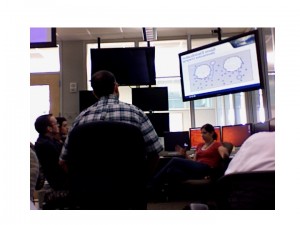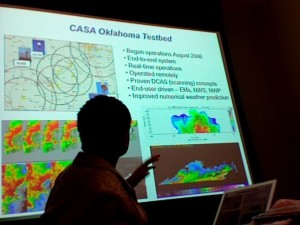Luckily, we were able see real-time data with the LMA, CASA, and PAR systems, along with the WDSS-II multi-radar algorithms. When compared to the archived cases, real-time operations provided a much better picture of the challenges operational forecasters will have in base data interpretation, primarily due to the more realistic warning environment. Below are some of the main points that I would like to make about each system:
LMA: With its quick updates, the 1km data aided in locating areas of updraft intensification and deviant motion trends. The ability to see the trend data was also a good indicator of storm strength/trend, especially in radar-sparse areas. Future research will hopefully lead to additional tools for storm/warning forecasting and warnings.
CASA: Although rapid updates from multiple radars can be overwhelming at times, the increased temporal and spatial resolution are well worth it. To alleviate the rapid-fire of new radar scans from 4 separate radars, the multi-radar composite was utilized with success. Especially in areas with sparse/distant radar coverage, this system should easily increase probabilities of detection and lead-times of severe weather events. However, due to the detection of features not previously seen on the 88D, an increase in false alarm rate is also expected. I also found that the sector scanning strategies took away from base data interpretation. Perhaps being able to manually control what sector is scanned would help in these situations.
PAR: The rapid scans, along with higher resolutions above the traditional “spit-cuts”, were outstanding. This helped increase the confidence of meso-cyclone and core strengths. The ADAPTS strategy appeared to work quite well without compromising the base data moments. Hopefully in the not-so-distant future, additional panels will be added to alleviate the beam broadening on the edges of our current panel, and allow a greater radar coverage area.
Multi-radar/Multi-sensor algorithms: In my experience, the use of MESH and reflectivities at 0C and -20C increase warning confidence tremendously. Other diagnostic products, such as MESH Swath, Rotation Tracks, etc… are also great tools to help with warning confidence and warning polygon construction. Especially in areas where radar coverage is sparse/distant with respect to your targets, these algorithms are needed. After using the multi-radar data in this workshop, and also in real-time operations at my office, I feel the products greatly enhance warning and non-warning decisions.
Kevin Brown (NWS Norman OK – 2009 Week 3 Evaluator)



